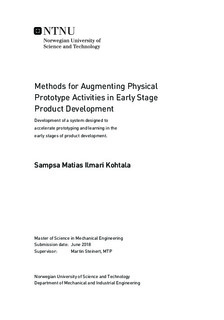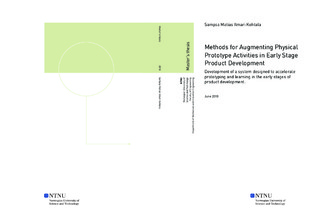| dc.description.abstract | In product development and engineering design research, discoveries have revealed the benefits of using prototypes and prototyping to increase the probability of successfully making new innovative and novel products. With the increasing competition in the global markets, innovation is key for sustainability and competitiveness. In the early stage of product development, large solution spaces are explored along with ambiguous information and uncertainty. This critical stage will greatly affect the cost and quality of later development activities, such as optimization and manufacturing.
This thesis aims to augment physical prototype activities in the early stages of product development by introducing state-of-the-art technologies and alternative design approaches, to make the process simpler and faster in many scenarios. The goal is to allow the generation of more design iterations in the pre-requirement stages, ultimately increasing the probability of making better products faster.
The main methods explored are photogrammetry-based 3D scanning, converting hand drawn sketches to physical parts, documenting microcontroller-based prototypes and using object recognition frameworks. These methods have been developed and implemented into a physical system called Protobooth v2, that users can interact with to make prototypes and accelerate learning, intended for both experienced and inexperienced product developers and teams. This system builds on an ongoing research project at the TrollLabs laboratory at NTNU in Trondheim, aiming to capture prototypes to enable research on early stage product development.
Each of the main methods have been developed into functional prototypes and are presented with experiments and practical examples. They have been implemented with the physical Protobooth v2 system. Using Protobooth v2 is simple and it demonstrates a potential for augmenting physical prototype activities, by converting complex models to digital representations and documenting microcontroller output. Additionally, by utilizing computer vision and artificial neural networks, the system can automatically detect and recognize components to provide useful information about the components while building prototypes. | |

